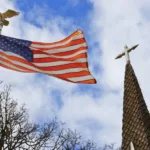A panel of religious leaders at Duke University examined the role of “sacred space” in their respective belief systems following a controversial decision – later reversed – to permit use of the Duke chapel bell tower as a minaret. The initial decision by officials at the Durham, NC School to permit a “moderately amplified” Islamic call to prayer on Friday afternoons from atop the historic chapel was met with criticism from Billy Graham Evangelistic Association President Franklin Graham and a number of other Christian leaders.
“How we understand and negotiate those claims about sacred space among different faiths is as important as ever at this time and in this place as events of this semester have made clear,” said Duke Chapel Dean Luke Powery, a Baptist minister who moderated the February 25 “Bridge Panel” featuring Christian, Jewish and Muslim campus leaders and co-sponsored by the Duke Undergraduate Faith Council.
Despite claims that sacred space is central in the practices of many faith traditions, panelists resisted offering firm examples on what spaces were sacred or profane/ordinary. Instead, panelists asked questions of their own about hospitality and the ethic or prioritization of use of chapel space. At no point did panelists address that communities could reserve sacred spaces exclusively for worship in their own tradition, while offering hospitality to other faiths by making available non-consecrated spaces.
In opening remarks, Powry noted that Duke Chapel is regarded as sacred space because it is an icon of the university and hosts important events for the school.
“It is considered sacred by some in the Duke community the way that a flag can be considered sacred – as a powerful symbol of pride and belonging,” Powry asserted, acknowledging that it is also a space for Christian worship that “holds a Christian confessional identity.”
The dean reported that the chapel convenes groups from over two dozen religious traditions and is “a sanctuary of hospitality and care” in which office, religious and meeting spaces are provided for numerous religious groups.
Dr. Ellen Davis, Professor of Bible and Practical Theology at United Methodist Duke Divinity School, defined sacred space as “symbolically interpreted space.” Davis suggested that Goodson Chapel at Duke Divinity School and the campus synagogue in the Freeman Center were the closest to sacred space because they were mostly – though not exclusively – devoted to worship and were built by and for one particular faith community.
The Duke Chapel, in contrast, was characterized by Davis as a “multipurpose space” that was built by and for the University and not by and for the United Methodist Church, despite the school’s historic ties to the denomination.
“I would say that Duke Chapel is sometimes sacred space with different parts of it sanctified at different times,” Davis assessed, proceeding to explain that the building’s nave was used both as a church and as an auditorium for “ambiguously religious” academic events. Davis noted that the tower serves as the University’s carillon.
“As far as I am aware, it functions as a distinctly church tower only on Sunday mornings when it performs the ordinary purpose of a church tower of ringing bells a few minutes before worship,” Davis reported, adding that the bell is also tolled 33 times on the afternoon of Good Friday.
“Should it perform the ‘normal’ function of a minaret on Friday afternoon?” Davis mused. “Does an explicitly verbal proclamation of faith from the bell tower, would that be a different act from the ringing of bells or the playing of carillon tunes?”
Duke Islamic Studies Center Director Dr. Omid Safi explained that in Islamic understanding, the totality of the Earth is sacred.
“The prophet [Mohammed] is quoted as saying ‘the whole Earth is a mosque,’” Safi noted. “It is when we invoke the presence of God that we create sanctity in a place.”
Safi steered the discussion to a question of privilege and access to facilities, noting opposition to the “Ground Zero Mosque” project in New York and instances of vandalism against Muslim places of worship.
“Is our model fundamentally a model of hospitality, or is it one of citizenship?” Safi questioned. “Is the notion that some of us own this house ‘and you are welcome to come to my house as long as you leave in three days’ or is the notion that this is God’s house and we all are participants in it in equal measure?”
Rebecca Simons, director for Jewish Life at Duke, proposed that people need sacred space as a reminder that they must connect with God’s divine presence.
“It is not the space itself of the tabernacle that allows people to connect with God, it is the reminder that they as people need to feel God,” Simons explained. “It is the people who make the space sacred, not the space itself. The space without people is no longer holy; it is the people who bring sanctity to the space.”
Asked if there was space that was profane, speakers pushed back, arguing that space was sacramental or even “unclean but not necessarily profane” in the words of Simons.
“I like the sense that all time – even ordinary time – has a sacredness to it,” offered Associate Dean for Religious Life at Duke Chapel Christy Lohr Sapp.
“I think we have to be careful that we don’t turn an icon into an idol,” Sapp warned. “Icons are meant to provide a window into the divine … but they themselves are not divine.”
Safi pointed out that a number of student communities were unable to construct their own places of worship like the Goodson Chapel or Freeman Center.
“How do we recognize the differential of resources plus the acknowledgement that this is still your home, that you belong here?” Safi asked. “Are we willing, at the risk of being somewhat chaotic, to say that we are going to open up the public space so that everyone that is here can be recognized and the goal is to somehow have the symphony of religious participation?”
Safi observed that Duke Chapel “obviously is set up as a Christian church” but that the Dean reports to the University President and that “whatever congregation worships here” is not Baptist, Catholic, Greek Orthodox, or Methodist. Instead, the congregation is “our Duke community” and that the chapel’s statue of Confederate General Robert E. Lee was evidence of a historic heritage that was not strictly religious.
Pointing to the community as having a Christian heritage but simultaneously recognizing Muslims, Jews, Hindus, Taoist, Atheist, Secularist, and Humanist people who call Duke home, Safi asked if the prevailing ethic was “a language of fear” or “a language of love.”





Comment by Matt on February 27, 2015 at 5:44 pm
Check out the letter Richard Hays (Dean of Duke Divinity) sent to student in the wake of this controversy.
Comment by King of Scotland on April 20, 2016 at 5:11 pm
Nobody cares.